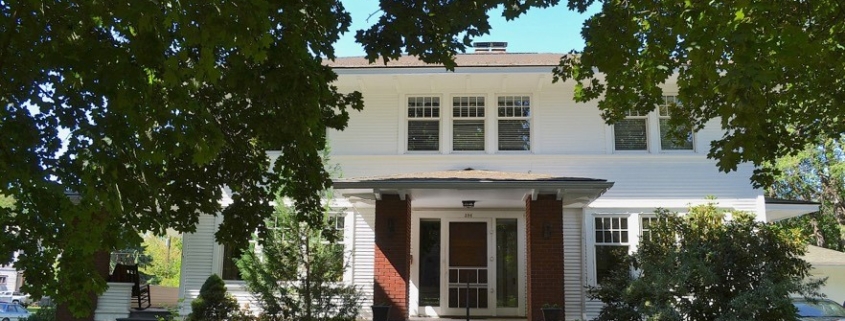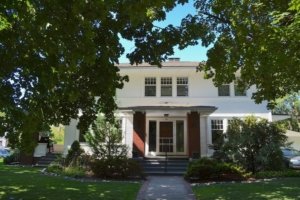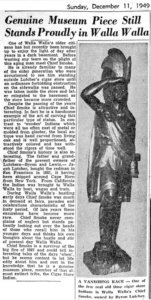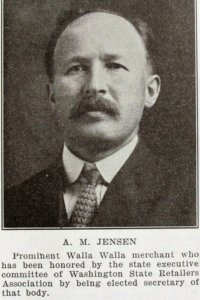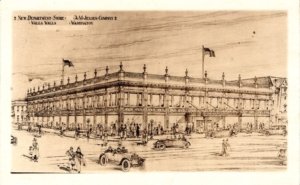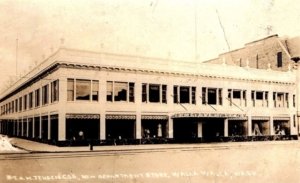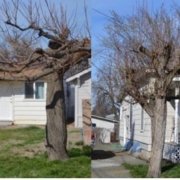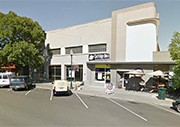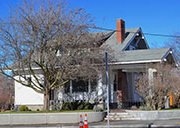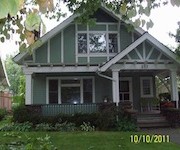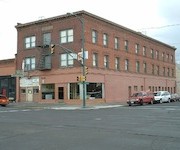History of 396 South Palouse Street – Walla Walla, WA
Legal Description
Commencing on the North line of Newell Street, in the City of Walla Walla, Washington, 310 feet Easterly, measured along said North line of Newell Street from the East line of Catherine Street, thence Easterly along the Northerly line of Newell Street 90 feet; thence at right angles Northerly to the Northeast corner of Lot 3, Block 27 of Roberts’ Addition to said City; thence Westerly along the Northerly line of Lots 3 and 4 in said Block 27 of Roberts’ Addition 90 feet; thence South at right angles to the point of beginning, being all of Lot 3 and a part of Lot 4 in Block 27 of said Roberts’ Addition to the City of Walla Walla, Washington.
Title and Occupant History
Washington Territory was created in 1853. In 1854, the new territorial legislature created Walla Walla County, which stretched from the crest of the Cascade Mountains to the crest of the Rocky Mountains in the present states of Washington, Idaho and Montana. In 1855, Isaac Stevens, governor of Washington Territory, held a council on the banks of Mill Creek at the present site of Walla Walla with representatives of regional Indian tribes to purchase land from them. The Yakamas, Cayuses and Walla Wallas were dissatisfied with the treaties and the intrusion by whites into their lands before the treaties’ ratification, and war followed. Missionaries, former French-Canadian employees of the Hudson Bay Company trading post at Wallula, and soldiers at the military Fort Walla Walla were the primary European occupants of the area prior to 1859, when the treaties were finally ratified and the land was opened for settlement. The transfer of ownership occurred by virtue of a treaty signed on June 9, 1855 in Walla Walla and ratified on March 8, 1859 by President James Buchanan, in which all of the land in the Walla Walla area was acquired from the Cayuse and Walla Walla Indian tribes.
The town of Walla Walla was originally laid out by County Surveyor Hamet Hubbard Case in 1859, prior to its formal incorporation as a city in 1862, as a one-quarter mile square with its eastern side centered on the point where Main Street crossed Mill Creek (at roughly the point where it does now). The original plat was lost, probably in the fire of 1865. Thus, the earliest plat on file is one made by W. W. Johnson, City Surveyor, in July 1865 that claims to have made corrections to Case’s survey. Johnson’s survey was made the official plat of the City of Walla Walla on September 25, 1866, was filed and recorded July 5, 1867.
A. B. Roberts and his wife, Martha, left Portland, Oregon. In 1859, traveling upriver to The Dalles, and eventually by land on to Wallula, W.T. From there they ventured on to Fort Walla Walla, at that time located along what is now East Main Street east of 1st, where Roberts determined to remain, purchasing property from Tom Hughes near the current northeast corner of 1st and Alder Street for $250. He constructed a house of canvas and poles about 150 feet south of that corner. He fenced in additional land around his rudimentary house and held it until the small town was surveyed. Roberts was one of 42 men selected to run for city office in 1862 in an effort to curb crime in Walla Walla; it appears he was neither elected nor appointed to office.
Eventually A. B. and Martha Roberts extended their holdings, including acreage granted by the United States Government under the Homestead Act that ranged from approximately First Street on the west to approximately Howard Street on the east, and from approximately L Street on the south to Alder Street to the north. Platted in 1870, the land was recorded January 20, 1871 as Roberts’ Addition to the City of Walla Walla.
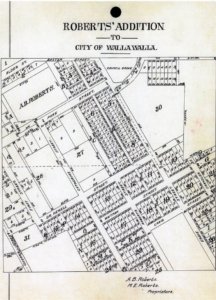
The original plat map of Roberts’ Addition to the City of Walla Walla. Note Lot 4 that traverses the full length of Newell Street from Catherine Street to South Palouse Street. Courtesy TitleOne.
The 1870 plat map of Roberts’ Addition shows Block 27 to contain just three building lots along Birch Street at Catherine, that were later acquired by St. Paul’s Episcopal Church. Lot 4, undivided, extended the entire length of Newell Street from South Palouse Street to Catherine Street. Exactly when Block 27 was subdivided into smaller building lots is unknown, although the first Warranty Deed for this property, dated 1/29/1879, is for the sale of Lot 3 and a portion of Lot 4. TitleOne, formerly Pioneer Title & Escrow, has a glass negative plat map of Roberts’ Addition Block 27; however, it is so milky it cannot be read, and no hard copy print exists. A search at the Auditor’s Vault for the plat map for Block 27 was unsuccessful. It would appear, however, that the block was divided into multiple building lots within a few years of the 1870 platting of Roberts’ Addition.
1/29/1872, Warranty Deed, A. B. and Martha E. Roberts, grantors; Lizzie Dexter, grantee, Lots 3 and 4 of Block 27 of A. B. Roberts’ Addition to the City of Walla Walla, $325 for the “quiet and peaceable possession of the party of the second part…”
2/2/1872, Warranty Deed, Lizzie and J. B. Dexter, grantors; William Stephens, grantee, same as 1/29/1872, $450. William Stephens owned extensive holdings in and around Walla Walla.
6/26/1874, Warranty Deed, William Stephens, grantor; B. L. Sharpstein, grantee, Lot 3 and a part of Lot 4, Block 27, $650. Judge Benjamin Sharpstein was an early prominent resident of Walla Walla, having arrived here from the Midwest in the 1860s. Along with his three sons, he became one of the Washington Territory’s most prominent lawyers.
1/29/1879, Warranty Deed, B. L. and Sarah Sharpstein, grantors; Anna L Painter, grantee, Lot 3 and part of Lot 4, $300.
5/1/1880, Warranty Deed, Anna S. and J. C. Painter, grantors; C. C. McCoy, grantee, same as Warranty Deed of 1/29/1879, $650.
6/19/1883, Warranty Deed, C. C. and Martha McCoy, grantors; Mack F. Gose, grantee, same as Warranty Deed of 1/29/1879, $1. Mack Gose was educated at Whitman Seminary, began practicing law in Pomeroy, Washington Territory, and was eventually an Associate Justice of the State Supreme Court 1909-1915. Upon retirement he took up farming.
6/19/1883, Warranty Deed, Mack F. Gose grantor; Martha McCoy, grantees, same as Warranty Deed of 1/29/1879, $1.
4/6/1895, Indenture, C. C. and Martha McCoy, grantors; The Baker-Boyer National Bank, grantee, same as Warranty Deed of 1/29/1879, also including a number of parcels in the Original Plat of the City of Walla Walla.
6/14/1900, Agreement for Deed, Baker-Boyer National Bank, grantor; W. B. Hamilton et al, grantee, same as Warranty Deed of 1/29/1879, $2,500: $1,400 due on closing, $1,100 due on or before 6/1/1905. William B. Hamilton was a farmer with residence at 235 Newell Street.
5/11/1905, Warranty Deed, W. B. and Kedillia Anna Hamilton, grantors; Andrew Larsen, grantee, same as Warranty Deed of 1/29, 1879, $3,800. Mr. Larsen was a bartender residing at 205 Colville Street.
7/21/1905, Warranty Deed, Andrew and Della Larsen, grantors; Christian A. Bowers, grantee, same as Warranty Deed of 1/29/1879, $4,200. Mr. Bowers was a farmer who resided at 229 Newell Street.
11/15/1907, Deed, Christian J. and Laura W. Bowers, grantors; Adna Sharpstein, grantee, same as Warranty Deed of 1/29/1879, $4,000. It is possible that Adna is a misspelling of the Benjamin Sharpsteins’ daughter Ada; such misspellings were common on early deeds.
6/12/1911, Deed, Adna Sharpstein, now of New York City, grantor; Emma Gregg, grantee, same as Warranty Deed of 1/29/1879, $6,500.
11/8/1913, Indenture, Herbert C. and Emma Gregg, grantors; The Baker Loan & Investment Company, grantee, same as Warranty Deed of 1/29/1879, $1.
3/17/1916, Indenture, The Baker Loan & Investment Company, grantor; Albert M. and Effie Jensen, grantees, same as Warranty Deed of 1/29/1879, $3,000 in gold coin. A. W. Jensen was owner of A. W. Jensen Company Department Store.
12/20/1951, Warranty Deed, Effie Jensen, a widow, grantor; Lewis C. and Edyth E. Lutcher, grantees, (see preceding Full Legal Description), $10 and other valuable considerations. Lewis Lutcher (1907-1994) was a lifelong Walla Walla resident and a member of the family that started Lutcher Bros. Billiards, Tobacco, Cigars and Confections on Main Street in 1883. The cigar store Indian, Chief Smoke, stood in front of Lutcher’s store for years. Chief Smoke is currently housed inside the entrance of Fort Walla Walla Museum.
1/14/1994, Quit Claim Deed, Lewis C. Lutcher, grantor; Edyth E. Lutcher, grantee, same as Warranty Deed of 12/20/1951.
1/26/1994, Quit Claim Deed, Edyth E. Lutcher, grantor; Gregory L. Lutcher and Linda Weitz, in her separate capacity of tenants in common “reserving a life estate in grantor,” grantees, same as Warranty Deed of 12/20/1951.
3/11/1999, Quit Claim Deed, Gregory L. Lutcher and Linda Weitz, grantors; Edythe E. Lutcher, a single person, grantee, same as Warranty Deed of 12/20/1951, “for love and affection.”
3/30/1999, Statutory Warranty Deed, Edyth E. Lutcher, a single person, grantor; Dennis R. Kleinbach, grantee, same as Warranty Deed of 12/20/1951.
5/22/2001, Statutory Warranty Deed, Dennis R. Kleinbach, a single person, grantor; David E. and Christy Ann Hall, grantees, same as Warranty Deed of 12/20/1951.
1/13/2003, Quit Claim Deed, Christy Ann Hall, grantor; David E. Hall, as his separate property, grantee, same as Warranty Deed of 12/20/1951.
12/12/2003, Quit Claim Deed, David E. Hall, grantor; The Hall Family Trust of 1999, grantee, same as Warranty Deed of 12/20/1951.
6/8/2006, Warranty Deed, The Hall Family Trust of 1999, grantor; Craig P. and Annette Dreher, grantees, same as Warranty Deed of 12/20/1951, $10 and other valuable considerations.
1/4/2012, Quit Claim Deed, Craig P. and Annette Dreher, grantors; Craig P. Dreher, grantee, same as Warranty Deed of 12/20/1951.
3/1/2013, Warranty Deed, Craig P. Dreher, grantor; Willem R. Rasmussen, grantee, same as Warranty Deed of 12/20/1951.
9/24/2015, Statutory Warranty Deed, Willem R. Rasmussen, grantor; Daniel Lynn Smith, grantee. Mr. Smith and Brenda Bernards and the current owners of 396 South Palouse Street.
Construction of the Building
Albert M. Jenson [sic] was granted Building Permit 2238 on August 1, 1916 to construct a “new dwelling at Palouse and Newell,” for which he paid a fee of $5.00. Estimated cost of construction was $6,500. Aug Granstrand was listed as contractor. (John August “Aug” Granstrand was a contractor with residence at 821 Lincoln Street, a house that he built in 1909.) Architect for 396 South Palouse Street was Charles B. Lambert, who was also a general contractor; thus the selection of Mr. Granstrand to construct the house seems unusual. Lambert was a proficient and well-known architect whose main competition was likely limited solely to Walla Walla’s most prominent architect, Henry Osterman.
Albert M. Jensen was born in Denmark in 1868. After serving six months in the Danish navy, he emigrated to the United States in 1890. Employed at St. Paul’s largest department store, he married Effie Byland of Indiana in 1897, with whom he had three children. The Jensens moved on to Walla Walla in 1910, where Jensen operated his first department store in the old Jones Building at 2nd and Alder. The Jones Building suffered a serious fire in January 1912, but Jensen’s store remained on site. (The current building on that corner is the former First National Bank, now the headquarters of Banner Bank.)
In 1920, Jensen hired the Beezer Brothers architectural firm of Seattle to design a new department store. The twin brothers Beezer were from Pittsburgh, but had established a significant career in Seattle. They had been hired to design the Baker-Boyer National Bank, extant on the corner of 2nd and Main, and they designed the former First National Bank, considered their finest bank design anywhere. Other than in Seattle, the Beezers designed and/or constructed more buildings in Walla Walla than in any other Northwest city, including the old St. Mary’s Hospital (demolished), the Peoples State Bank (now Martin’s Jeweler) and a Gothic mini-cathedral for First Congregational Church (unbuilt).
The new A. M. Jensen Company Department Store on East Main Street at Colville Street opened in 1920. It is an elegant building clad in white glazed terra-cotta. Because of its huge plate glass windows it was known as the “Daylight Store.” Regrettably, a portion of its original ornamentation has been removed over the years and the exterior of the street level has been severely altered. Allied Stores purchased it in 1946 when it became a branch of Seattle’s largest department store, The Bon Marché. Macy’s took over operation of The Bon Marché from Allied Stores in 2005 and the Walla Walla store was operated as a Macy’s until it was closed in March 2020. The current future of this iconic building is unknown, likely due in part to the pandemic of 2020-21.
Albert Jensen was a Scottish Rite Mason and a member of the Independent Order of Odd Fellows. He served on the Board of the Commercial Club. He died in 1948, and was survived by his widow who died in 1954, although she sold their house in 1951.
Architect Charles B. Lambert was born in Sweden in 1871. He went to sea at the young age of 14, but returned to Sweden to study architecture when he was but 17 years old. Like Jensen, Lambert emigrated to the United States in 1890, settling first in Chicago, then St. Paul, later moving to Alaska, arriving in Walla Walla in 1898, where he married Alma Jones, also from Sweden, in 1901. The Lamberts had two children and resided at 609 East Alder Street, a house he designed that is still at that address.
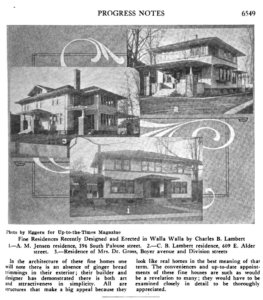
Up-To-The-Times magazine in March 1917 featured these three houses designed by Charles Lambert. The Jensen house is Number 1.
The County Assessor dates 396 South Palouse Street to 1918. Assessor build dates are frequently estimates. The Walla Walla City Directory combined the years 1916 and 1917 in a single volume that does not show the Jensens on South Palouse Street. Their first listing at 396 South Palouse is in the 1918 directory. In that the building permit to construct the house was issued in mid-1916, construction most surely commenced that year, but 1917 is more likely the year it was completed and occupied by the Jensens.
396 South Palouse Street essentially reflects Prairie style architecture that was popular during the first decade of the 20th century, more so in the Midwest than the Pacific Northwest. It is a rectangular house displaying typical Prairie style characteristics including a low pitched hipped roof, wide overhanging eaves, the bottoms of which are boxed in to be perpendicular to the walls, a large one-story porch on the south side with a hipped roof, the eaves of which extend slightly beyond the extremities of the house proper, and a smaller hipped roof, centrally located front porch; both porches are supported by massive brick pillars. All elements of the house emphasize a horizontal linear flow, from the clapboard siding to the windows of the second floor that come into contact with the boxed in bottom of the eaves above and feature a narrow stringcourse, or raised band of wood, directly below them (see the illustration on Page 8 in which this banding increases the horizontal feel of the house due to its darker color than the siding, almost defining the windows that “rest” on it as ribbon windows; this is diminished by the fact that currently the band is painted the same color as the siding). In employing this novel style of architecture in Walla Walla, Mr. Lambert may have been a bit more progressive than his fellow architects, despite the fact that he was preceded in this design by the 1909 house at 1415 Modoc Street that was based on a 1907 design by Frank Lloyd Wright.
Resources
- TitleOne (formerly Pioneer Title & Escrow)
- Walla Walla City Directories, various years
- Sanborn Fire Insurance Maps (1905)
- Whitman Archives (via email with Dana Bronson, Associate Archivist)
- Up-To-The-Times monthly magazine, Walla Walla, March 1917
- W.D. Lyman, History of Old Walla Walla County, Vol. 2, The S. J. Clarke Publishing Company, Chicago, 1918
- Bureau of Land Management General Land Office Records
- Census Records, various years
- Mountain View Cemetery burial records
- myheritage.com
- Drazan, Joe, Bygone Walla Walla blog

